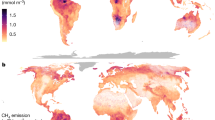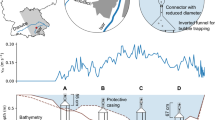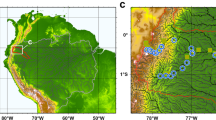Abstract
Inland waters are large sources of methane to the atmosphere. However, considerable uncertainty exists in estimating the emissions of this potent greenhouse gas from global streams and rivers due, in part, to a lack of direct measurements in the high-altitude cryosphere and poor accounting for ebullition. Here we present methane concentrations and fluxes over three years in four basins on the East Qinghai–Tibet Plateau. Methane ebullition rates decrease exponentially whereas diffusion declines linearly with increasing stream order. Nonetheless, the average ebullition rate (11.9 mmolCH4 m−2 d−1) from these streams and rivers—which have large organic stocks in surrounding permafrost, abundant cold-tolerant methanogens, shallow water depths, and experience low air pressure—were six times greater than the global average and reached a maximum of 374.4 mmolCH4 m−2 d−1. Upscaled total emissions from sampled third- to seventh-order waterways of the East Qinghai–Tibet Plateau are estimated to be 0.20 TgCH4 yr−1, 79% of which was attributed to ebullition. These methane emissions are approximately 20% of CO2 emissions (2.70 TgCO2 yr−1) in terms of carbon release and two times greater in terms of CO2-equivalent emissions. When upscaled to first- to seventh-order waterways, we estimate emissions of 0.37–1.23 TgCH4 yr−1. Our findings demonstrate that high-elevation rivers on the Qinghai–Tibet Plateau are hotspots of methane delivery to the atmosphere. The large ebullitive fluxes, which constitute a substantial fraction of global fluvial methane emissions, reveal a positive feedback between climate warming, permafrost thaw and methane emissions.
This is a preview of subscription content, access via your institution
Access options
Access Nature and 54 other Nature Portfolio journals
Get Nature+, our best-value online-access subscription
$29.99 / 30 days
cancel any time
Subscribe to this journal
Receive 12 print issues and online access
$259.00 per year
only $21.58 per issue
Buy this article
- Purchase on Springer Link
- Instant access to full article PDF
Prices may be subject to local taxes which are calculated during checkout





Similar content being viewed by others
Data availability
The data are available at the Environmental Data Initiative (https://doi.org/10.6073/pasta/d04ae85f579c60a5b751749a46f9b77b). All sequences reported in this study were deposited in NCBI Short Read Archive (SRA) under the BioProject accession number PRJNA605704.
Code availability
The Monte Carlo model code is available at the Environmental Data Initiative (https://doi.org/10.6073/pasta/d04ae85f579c60a5b751749a46f9b77b).
References
Bastviken, D., Tranvik, L. J., Downing, J. A., Crill, P. M. & Enrich-Prast, A. Freshwater methane emissions offset the continental carbon sink. Science 331, 50 (2011).
Stanley, E. H. et al. The ecology of methane in streams and rivers: patterns, controls, and global significance. Ecol. Monogr. 86, 146–171 (2016).
Immerzeel, W. W. & Bierkens, M. F. P. Asia’s water balance. Nat. Geosci. 5, 841–842 (2012).
Yang, M., Wang, X., Pang, G., Wan, G. & Liu, Z. The Tibetan Plateau cryosphere: observations and model simulations for current status and recent changes. Earth-Sci. Rev. 190, 353–369 (2019).
Ran, Y., Li, X. & Cheng, G. Climate warming over the past half century has led to thermal degradation of permafrost on the Qinghai–Tibet Plateau. Cryosphere 12, 595–608 (2018).
Jin, H. J., Chang, X. L. & Wang, S. L. Evolution of permafrost on the Qinghai-Xizang (Tibet) Plateau since the end of the late Pleistocene. J. Geophys. Res. Earth Surface 112, F02S09 (2007).
Vonk, J. E. & Gustafsson, Ö. Permafrost-carbon complexities. Nat. Geosci. 6, 675–676 (2013).
Street, L. E. et al. Redox dynamics in the active layer of an Arctic headwater catchment; examining the potential for transfer of dissolved methane from soils to stream water. J. Geophys. Res. Biogeosci. 121, 2776–2792 (2016).
Lamarche-Gagnon, G. et al. Greenland melt drives continuous export of methane from the ice-sheet bed. Nature 565, 73–77 (2019).
Wik, M., Crill, P. M., Varner, R. K. & Bastviken, D. Multiyear measurements of ebullitive methane flux from three subarctic lakes. J. Geophys. Res. Biogeosci. 118, 1307–1321 (2013).
Natchimuthu, S. et al. Spatio-temporal variability of lake CH4 fluxes and its influence on annual whole lake emission estimates. Limnol. Oceanogr. 61, S13–S26 (2016).
Mattson, M. D. & Likens, G. E. Air pressure and methane fluxes. Nature 347, 718–719 (1990).
Wik, M., Varner, R. K., Anthony, K. W., MacIntyre, S. & Bastviken, D. Climate-sensitive northern lakes and ponds are critical components of methane release. Nat. Geosci. 9, 99–105 (2016).
Wilhelm, E., Battino, R. & Wilcock, R. J. Low-pressure solubility of gases in liquid water. Chem. Rev. 77, 219–262 (1977).
Wang, Y. et al. Selective leaching of dissolved organic matter from alpine permafrost soils on the Qinghai-Tibetan Plateau. J. Geophys. Res. Biogeosci. 123, 1005–1016 (2018).
Wild, B. et al. Rivers across the Siberian Arctic unearth the patterns of carbon release from thawing permafrost. Proc. Natl Acad. Sci. USA 116, 10280–10285 (2019).
Wang, Y. et al. Spatiotemporal transformation of dissolved organic matter along an alpine stream flow path on the Qinghai-Tibet Plateau: importance of source and permafrost degradation. Biogeosciences 15, 6637–6648 (2018).
Yang, Y. et al. Delineating the hydrological processes and hydraulic connectivities under permafrost degradation on Northeastern Qinghai-Tibet Plateau, China. J. Hydrol. 569, 359–372 (2019).
Mackelprang, R. et al. Metagenomic analysis of a permafrost microbial community reveals a rapid response to thaw. Nature 480, 368–371 (2011).
Boetius, A., Anesio, A. M., Deming, J. W., Mikucki, J. A. & Rapp, J. Z. Microbial ecology of the cryosphere: sea ice and glacial habitats. Nat. Rev. Microbiol. 13, 677–690 (2015).
Zhang, S. et al. Ammonia oxidizers in high-elevation rivers of the Qinghai-Tibetan Plateau display distinctive distribution patterns. Appl. Environ. Microbiol. 85, e01701–e01719 (2019).
Yergeau, E., Hogues, H., Whyte, L. G. & Greer, C. W. The functional potential of high Arctic permafrost revealed by metagenomic sequencing, qPCR and microarray analyses. ISME J. 4, 1206–1214 (2010).
Fasching, C., Ulseth, A. J., Schelker, J., Steniczka, G. & Battin, T. J. Hydrology controls dissolved organic matter export and composition in an Alpine stream and its hyporheic zone. Limnol. Oceanogr. 61, 558–571 (2016).
Bastviken, D. et al. Methane emissions from pantanal, South America, during the low water season: toward more comprehensive sampling. Environ. Sci. Technol. 44, 5450–5455 (2010).
Liu, S., Lu, X. X., Xia, X., Yang, X. & Ran, L. Hydrological and geomorphological control on CO2 outgassing from low-gradient large rivers: an example of the Yangtze River system. J. Hydrol. 550, 26–41 (2017).
Romeijn, P., Comer-Warner, S. A., Ullah, S., Hannah, D. M. & Krause, S. Streambed organic matter controls on carbon dioxide and methane emissions from streams. Environ. Sci. Technol. 53, 2364–2374 (2019).
Hotchkiss, E. R. et al. Sources of and processes controlling CO2 emissions change with the size of streams and rivers. Nat. Geosci. 8, 696–699 (2015).
Shelley, F., Ings, N., Hildrew, A. G., Trimmer, M. & Grey, J. Bringing methanotrophy in rivers out of the shadows. Limnol. Oceanogr. 62, 2345–2359 (2017).
Sawakuchi, H. O. et al. Oxidative mitigation of aquatic methane emissions in large Amazonian rivers. Glob. Change Biol. 22, 1075–1085 (2016).
Battin, T. J. et al. Biophysical controls on organic carbon fluxes in fluvial networks. Nat. Geosci. 1, 95–100 (2008).
Xia, X. et al. The cycle of nitrogen in river systems: sources, transformation, and flux. Environ. Sci. Process. Impacts 20, 863–891 (2018).
Abril, G., Commarieu, M.-V. & Guérin, F. Enhanced methane oxidation in an estuarine turbidity maximum. Limnol. Oceanogr. 52, 470–475 (2007).
Campeau, A., Lapierre, J.-F., Vachon, D. & del Giorgio, P. A. Regional contribution of CO2 and CH4 fluxes from the fluvial network in a lowland boreal landscape of Québec. Global Biogeochem. Cycles 28, 57–69 (2014).
Wallin, M. B. et al. Carbon dioxide and methane emissions of Swedish low-order streams—a national estimate and lessons learnt from more than a decade of observations. Limnol. Oceanogr. Lett. 3, 156–167 (2018).
Piao, S. et al. The carbon balance of terrestrial ecosystems in China. Nature 458, 1009–1013 (2009).
Allen, G. H. & Pavelsky, T. M. Global extent of rivers and streams. Science 361, 585–588 (2018).
Marcé, R. et al. Emissions from dry inland waters are a blind spot in the global carbon cycle. Earth-Sci. Rev. 188, 240–248 (2019).
Flury, S. & Ulseth, A. J. Exploring the sources of unexpected high methane concentrations and fluxes from Alpine headwater streams. Geophys. Res. Lett. 46, 6614–6625 (2019).
Dean, J. F. et al. Methane feedbacks to the global climate system in a warmer world. Rev. Geophys. 56, 207–250 (2018).
Saunois, M. et al. The global methane budget 2000–2017. Earth Syst. Sci. Data Discuss. https://doi.org/10.5194/essd-2019-128 (2019).
Mountain Research Initiative EDW Working Group. Elevation-dependent warming in mountain regions of the world. Nat. Clim. Change 5, 424–430 (2015).
Pekel, J.-F., Cottam, A., Gorelick, N. & Belward, A. S. High-resolution mapping of global surface water and its long-term changes. Nature 540, 418–422 (2016).
Zou, D. et al. A new map of permafrost distribution on the Tibetan Plateau. Cryosphere 11, 2527–2542 (2017).
Chen, H. et al. The carbon stock of alpine peatlands on the Qinghai-Tibetan plateau during the Holocene and their future fate. Quat. Sci. Rev. 95, 151–158 (2014).
Johnson, K. M., Hughes, J. E., Donaghay, P. L. & Sieburth, J. M. Bottle-calibration static head space method for the determination of methane dissolved in seawater. Anal. Chem. 62, 2408–2412 (1990).
Sawakuchi, H. O. et al. Methane emissions from Amazonian rivers and their contribution to the global methane budget. Glob. Change Biol. 20, 2829–2840 (2014).
Lorke, A. et al. Technical note: drifting versus anchored flux chambers for measuring greenhouse gas emissions from running waters. Biogeosciences 12, 7013–7024 (2015).
Raymond, P. A. et al. Scaling the gas transfer velocity and hydraulic geometry in streams and small rivers. Limnol. Oceanogr. Fluids Environ. 2, 41–53 (2012).
Steinberg, L. M. & Regan, J. M. mcrA-targeted real-time quantitative PCR method to examine methanogen communities. Appl. Environ. Microbiol. 75, 4435–4442 (2009).
Walters, W. et al. Improved bacterial 16S rRNA gene (V4 and V4-5) and fungal internal transcribed spacer marker gene primers for microbial community surveys. mSystems 1, e00009–e00015 (2016).
Lehner, B., Verdin, K. & Jarvis, A. New global hydrography derived from spaceborne elevation data. Eos 89, 93–94 (2008).
Kharab, A. & Guenther, R. An Introduction to Numerical Methods: A MATLAB Approach (CRC Press, 2018).
Verma, J. P. Data Analysis in Management with SPSS Software (Springer Science & Business Media, 2013).
Acknowledgements
We thank D. E. Butman for insightful discussions. This work was financially supported by the National Key R&D Program of China (grant no. 2017YFA0605001), the National Natural Science Foundation of China (grant no. 91547207) and the fund for Innovative Research Group of the National Natural Science Foundation of China (grant no. 51721093).
Author information
Authors and Affiliations
Contributions
X.X. and L.Z. designed the study. L.Z., S.Z., S. Li, J.W., G.W., H.G., Z.Z. and W.W. collected and analysed samples. S. Liu, Q.W. and R.L. conducted GIS and Monte Carlo analyses. X.X., L.Z., S. Liu, Z.Y., E.H.S. and P.A.R. performed data analysis and wrote the manuscript with substantial contributions from all co-authors.
Corresponding author
Ethics declarations
Competing interests
The authors declare no competing interests.
Additional information
Peer review information Primary Handling Editors: Tamara Goldin; Xujia Jiang.
Publisher’s note Springer Nature remains neutral with regard to jurisdictional claims in published maps and institutional affiliations.
Extended data
Extended Data Fig. 1 Geography of the four studied EQTP headwater basins, China.
a–c, Thermokarst ponds dot along the narrow stream corridors (> 4200 m). d, e, Streams meander through thawing permafrost or peatlands (4200–3400 m). f, Glacial ponds, lakes, and wetlands connect to headwater streams. g, Braided channels suffuse the entire QTP. h, The 5th order river channel (MD reach) of the Yellow River is wide (43.1 ± 29.8 m) but with shallow water depth (0.65 ± 0.13 m). i, Site locations in the four headwater river basins of the EQTP. j, Four headwater river basins underlain with the spatial extents of continuous, discontinuous, sporadic, and isolated permafrost on the EQTP (Data of permafrost distribution were obtained from Obu, J., Westermann, S., Kääb, A. & Bartsch, A. Permafrost Extent and Ground Temperature Map, 2000–2016, Northern Hemisphere Permafrost. https://apgc.awi.de/dataset/pex).
Extended Data Fig. 2 Box plots of seasonal and regional patterns of CH4 concentrations a, and fluxes b, from EQTP rivers.
Box plots present first and third quartiles; whiskers are minimum and maximum and line is median. Markers are outliers. Note the different scales and units.
Extended Data Fig. 3 CH4 ebullition as a function of DOC a, and SOC b, flow velocity c, and SOC d, as a function of Log (Q/w).
The red dashed lines are the fit of linear regressions for a, b and d; or exponential regression for c through observed data.
Extended Data Fig. 4 Methanogens: methanotrophs ratio a, SOC b, SS concentration c, total length d, and average width e, as a function of stream order.
Sixth and seventh order rivers meander through canyons, limiting their width. Thus, second through fifth order streams only were included in the regression used to predict the width of first order streams. The dashed red lines represent the fit of exponential regressions through observed data. All error bars show mean ± 1 s.e.m.
Extended Data Fig. 5
CH4 and CO2 emissions from EQTP alpine waterways.
Supplementary information
Supplementary Information
Supplementary Methods a and b, Discussion a–c, Fig. 1 and Tables 1–6.
Supplementary Video 1
Visible bubbles erupting from a shallow stream sediment seep at JZ (see Supplementary Table 1), where there are substantial thawing permafrost surrounding, and the ebullition persisted for more than 80 min (duration of sampling time) to sustain high CH4 ebullition rate (734.4 mmol m−2 d−1).
Rights and permissions
About this article
Cite this article
Zhang, L., Xia, X., Liu, S. et al. Significant methane ebullition from alpine permafrost rivers on the East Qinghai–Tibet Plateau. Nat. Geosci. 13, 349–354 (2020). https://doi.org/10.1038/s41561-020-0571-8
Received:
Accepted:
Published:
Issue Date:
DOI: https://doi.org/10.1038/s41561-020-0571-8
This article is cited by
-
High methane ebullition throughout one year in a regulated central European stream
Scientific Reports (2024)
-
Characteristics of methane emissions from alpine thermokarst lakes on the Tibetan Plateau
Nature Communications (2023)
-
River ecosystem metabolism and carbon biogeochemistry in a changing world
Nature (2023)
-
Global methane emissions from rivers and streams
Nature (2023)
-
Unexpectedly minor nitrous oxide emissions from fluvial networks draining permafrost catchments of the East Qinghai-Tibet Plateau
Nature Communications (2022)



